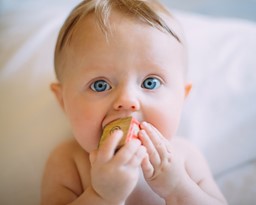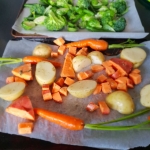
Welcome to part 2 of our “starting solids” blog. In the last post we focused on the more traditional “parent-led weaning” approach.
You can check this one out here: Starting solids, parent-led weaning or baby-led weaning? – Let’s Eat! Feeding Therapy. This post will look at a feeding approach that has become more popular over the last decade – Baby-led Weaning. Most importantly, when choosing baby-led weaning, how do we keep our babies safe?

Baby-led weaning
Child Health Nurse, Gill Rapley, published her book on Baby-led weaning in 2008. Put simply, baby-led weaning means skipping the traditional puree/mashed stages of learning to eat solids that we use in parent-led weaning and moving straight onto finger foods. It involves:
- Bringing your child’s highchair to the table to eat with the family.
- Offering your baby small portions of family foods rather than puree/mashed baby foods.
- Encouraging your baby to feed himself. Lots of mess is a natural part of this approach.
- Providing breastmilk or formula between meals up until at least 12 months of age as per the World Health Organisation guidelines
- According to Gill Rapley’s book babies are not spoon fed or offered puree textures.
- More information can be found on Gill’s website Rapley Weaning – Fuss-free solids – Home
We don’t recommend BLW for babies
1. Who are having difficulties with growth
2. Who have oral hypersensitivity/gagging issues and
3. Babies who have special needs/ low muscle tone; these babies’ fine motor skills of chewing may take longer to develop than their peers.
With all of these groups, we suggest parent talk with their health professionals for individualised advice around feeding.
What foods do I offer?
When starting your baby on solid foods, there are two important safety considerations – choking and allergies.
In baby-led weaning, you offer your child whatever the family is eating (just reduce the salt and hot spices). Your child needs time to develop their chewing skills and so, in the beginning they will likely chew and spit a fair bit, not to mention, a lot lands on the floor!
But remember, your child needs time to develop their chewing skills so it’s important to consider how your family foods might be served to minimise any risk of choking. Just because baby-led weaning doesn’t involve purees, that does not mean you can’t modify the foods to make them safe for your baby. Remember, strict supervision is needed with all mealtimes as choking is silent!

Foods we recommend:
- Stewed fruit, e.g., apple, pear or peeled, soft fruit, e.g., peach, melon
- Peeled, roasted or steamed vegetables, e.g., potato, carrot, zucchini, broccoli
- Overcooked pasta, soft lentils, cruskits
- Low salt fetta, grated cheese, cheese sticks
- Soft-cooked white fish or salmon
- Iron rich foods are important with all babies starting solids so consider offering eggs, beef/lamb mince/bolognaise (added to pasta so it holds inside the shells/penne pasta), lightly fork mashed kidney beans and hummus spread on cruskits. Our area health network has some great tips here.
Foods we don’t recommend when starting baby-led weaning at 6-7 months:

As with all children, keeping your first aid up to date is essential, more so if you chose to use the BLW method with your child.
Allergy guidelines
The guidelines are the same no matter which approach you choose. ASCIA (our Allergy recommendations) recommend:
- Offer common allergy foods appropriate to your child’s skill level by 12 months of age including cooked egg, peanut, cow’s milk, tree nuts, soy and fish.
- Continue to give the food regularly if your baby has no reaction
- Include only one food at each meal so the allergen can be identified if your baby has a reaction
- If you’re baby has a reaction, stop giving the food and seek medical advice.
What does the research tell us about starting solids?
A systematic review (D’Auria et al 2018) looked into common areas of concern around BLW including
? Do babies who go through BLW have increased risk of choking? And
? Do BLW babies have better satiety (fullness)-responsiveness cues and
? Does BLW improve family relationships during shared meals?
They found that there is “insufficient evidence to draw conclusions about the BLW approach, in terms of adequacy of energy and nutrient intakes, due to the low quality of the evidence”.
More interesting was that mothers who used the BLW approach estimated that their babies had more milk feeds and less solids compared to those using the parent led (traditional) approach.
In all 12 studies included, only 2 were randomised control studies (the rest were observational) but both of these RCTs had potential bias so the overall quality of evidence was low. The systematic review recommended ongoing studies in the area (which would be great news for all of us health professionals to understand the potential risks and long term benefits of this approach).
We do have a preference for using both traditional and BLW when introducing solids and with this evidence, you as a parent can rest easy – you don’t have to pick – the research doesn’t prove that one is better than the other. So spoon feed your baby and give them soft stick sized pieces of finger foods to explore and develop their chewing skills. They will become more efficient with their chewing as they get closer to 10 months of age.
If you’re interested in baby-led weaning but unsure about your baby’s chewing skills, make an appointment with Let’s Eat! today. We would love to help you and your baby.
Until next time
Ashleigh
About this Author
Ashleigh O’Loughlin is a Speech Pathologist with 6 years’ experience; she has specific experience in feeding difficulties and children with Autism Spectrum Disorders and Special needs. She has worked all around Australia including remote Northern Territory and Perth (Western Australia). She joined the Let’s Eat Speech Team in 2020 and works with Valerie Gent in their clinic in Wallsend (and now in Telehealth). You can email Ashleigh now on ashleigh@letseatspeech.com.au or head to the website www.letseatspeech.com.au
References cited:
D’Auria, E., Bergamini, M., Staiano, A., Banderali, G., Pendezza, E., Penagini, F., Zuccotti, G. V., Peroni, D. G., & Italian Society of Pediatrics (2018). Baby-led weaning: what a systematic review of the literature adds on. Italian journal of pediatrics, 44(1), 49. https://doi.org/10.1186/s13052-018-0487-8
Rapley, G., & Murkett, T. (2008). Baby-led Weaning: Helping your child to love good food. Vermilion
